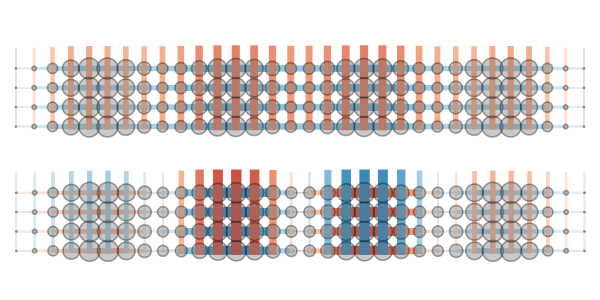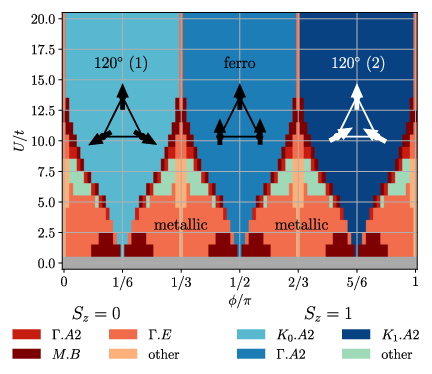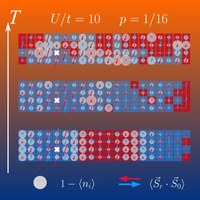
Research
A happy end for stripes and superconductors
The mechanism behind high-temperature superconductors has long been a great mystery to physicists. Even though the fundamental physical equations of interacting electrons in these materials are well-known, their solution has proved challenging. Whether or not superconductivity or the so-called "stripe order", where the density of electrons forms regular waves called "stripes", is realized has been an open question and these two states of matter have been considered in competition to one another.
This study now shows that stripe order and superconductivity can, in fact, get along with one another quite well. By performing exact numerical simulations on a minimal model for cuprate superconductors, the author demonstrates that there exist states of matter with exactly one superconducting condensate per stripe. Since there are multiple stripes in the systems, there are also multiple condensates, a phenomenon called "fragmentation". The physical picture proposed in this study agrees well with experimentsal observations and demonstrates the predictive power of modern numerical techniques to study quantum many-body systems.
Physics of the moiré Hubbard model
Twisted moiré materials are an exciting novel platform displaying a number of intriguing physical phenomena involving strong electron correlations. The moiré Hubbard model on a triangular lattice studied in this manuscript captures the effective low energy physics of an important class of homobilayer twisted transition metal dichalcogenides. In experimental studies, the parameters of this model can be tuned over a large range of values. In particular, a spin-dependent staggered magnetic flux can be controlled by applying gate voltages.
In this manuscript, we investigate the physical properties of this model, for which much remains to be understood. By combining state-of-the-art Exact Diagonalization and Density Matrix Renormalization Group simulations, we discover several fundamental properties and novel physical phenomena in this system.
The phase diagram at half-filling is found to be strongly dependent on the staggered flux. We establish the location of a metal-insulator transtition, several regimes of insulating magnetic states, and point towards the possibility of quantum spin liquids emerging at the boundary between these phases. Upon small hole or electron-doping, we find that the staggered magnetic flux controls the attractive force between holes (and electrons). Our study reveals that forming pairs of holes is energetically favorable but that only weak superconducting correlations emerge. This is consistent with the absence of superconductivity reported in experiments and also provides guidance for future experimental studies.
Mott Insulating States with Competing Orders in the Triangular Lattice Hubbard Model
The way in which electrons travel in a lattice of atoms determines many of their physical properties. This includes whether or not the material is a metal, if it exhibits magnetism, or whether exotic phenomena such as superconductivity are observed. The geometry of the atomic lattice is important: As many experiments have shown, if atoms are arranged in a 2D triangular lattice, a variety of fascinating phenomena emerge. However, such systems are challenging to understand and require researchers to employ and critically compare modern numerical techniques to gain insights. Here, we provide such a comparison by deploying multiple techniques to analyze the particularly interesting case of one electron per lattice site.
When the electrons interact weakly, we find that a metallic state arises; when interactions are stronger, we find an insulating state with many intriguing phenomena. We establish a paradoxical effect: As temperature increases, the electrons prefer to localize rather than fluctuate freely. This strange behavior is explained by a large entropy of the system at stronger interactions, to which many competing orders contribute. While different kinds of magnetic ordering challenge one another, we also observe a particularly interesting “handedness” or chirality of the system. These chiral correlations could be indicative of forming an elusive state of matter, called a chiral spin liquid, at low temperature.
The numerical techniques applied in this study demonstrate that they become increasingly powerful and allow for understanding notoriously difficult questions in strongly correlated electron physics.

Stripes, Antiferromagnetism, and the Pseudogap in the Doped Hubbard Model at Finite Temperature
A collection of interacting electrons in a solid can form a metal, exhibit magnetism, or become a superconductor. Since all these effects are relevant for technological applications, it is important to understand the mechanisms behind them. Here, we use a relatively new computational method to study a foundational model of superconductivity to see how the behavior of interacting electrons changes as temperature increases.
The Hubbard model is a simplified description of electrons in a solid that is believed to capture the essential electronic properties of many materials, including the high-temperature copper oxide, or cuprate, superconductors. However, despite long attempts to solve this model, understanding its phase diagram remains one of the most challenging and interesting endeavors in theoretical condensed-matter physics.
Using the recently developed “minimally entangled typical thermal state” computational technique to study this model, we make several interesting observations. When there are fewer electrons than lattice sites, we observe that the density of electrons forms a regular wavelike pattern. Upon increasing the temperature, this pattern melts, and we find a tendency of the system to order antiferromagnetically, which means that the spins of neighboring electrons prefer to point in opposite directions. Importantly, we find that in this regime, the system shares many features with the experimentally observed pseudogap regime of the cuprate superconductors.
Demonstrating the feasibility of this new kind of simulation paves the way toward understanding several most puzzling phenomena in solid-state physics, such as high-temperature superconductivity or strange metals.


